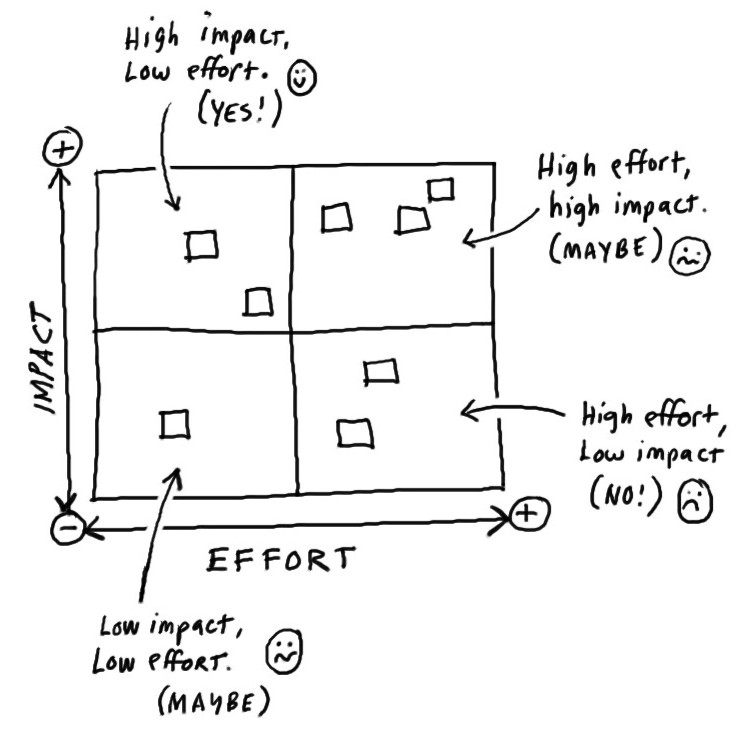Does this sound familiar? You are in a deadline-focused organization and the work to maintain and improve your website is ruled by the tyranny of the urgent. You’re constantly in reactive mode, responding to bugs, maintenance issues, and urgent feature requests. As a result, seizing opportunities to build greater value into your website go unexplored or sit perpetually on the horizon to be addressed “after [insert urgent issue].”
One of the best antidotes to being trapped on this treadmill is a product roadmap. This high-level guide prioritizes your website projects over a period of time without being rigid or overly detailed. It complements day-to-day agile work by ensuring tasks are focused on what will bring the greatest value to your audiences and your team members who manage the site. If organizational priorities or external factors shift, the roadmap can be adjusted.
A product roadmap also demonstrates to leadership that you are committed to strategic planning and work that supports the organization’s mission and goals.
What You Need to Create a Strategic Planning Roadmap
The following elements are essential to a strategic planning roadmap:
Stakeholder Collaboration
Too often, organizations implement website improvements without the input of those who manage the site or have a deep understanding of its audiences.
Schedule in-depth conversations with department stakeholders and leadership. What do these folks need from the website or its CMS? What do they think their audiences need? At Alley, we hold these discussions as part of project discovery and involve C-suite leadership, representatives from different departments, and people who share similar job functions.
For larger organizations, we often hold a series of in-depth conversations with key people or groups. For example, in our work with the National Council on Aging (NCOA), it was important to include leadership focused on content, corporate partnerships, and other departments. We documented pain points and identified what success would look like. Providing NCOA with a space where everyone could be heard cleared a path for impactful improvements and built internal buy-in for a cohesive product vision.
Audience Research
While stakeholders often have a great grasp on what their audiences want, there is certainly no better source than your site visitors themselves. When was the last time you talked to your website users? How confident do you feel in knowing who you are trying to reach and what these audiences want?
Use assets like your newsletter subscriber list to recruit people for surveys, roundtables, or in-depth interviews. Gather information about their behavior, how they view the site, and even potential new designs and features they would like to see.
Once you’ve collected this data, you should compare your audiences’ perspectives with the results of your stakeholder conversations. Does what you’ve learned through audience research support or differ from your internal teams?
Using a combination of stakeholder and audience input to fully understand what site visitors need, you can start developing a truly user-centric product roadmap.
Analytics
Website analytics are hardly a new tool. But amid the constant pressure of day-to-day operations, organizations can easily fall behind in reviewing their insights.
Your website data is a goldmine of information about user behavior. Metrics like bounce rates, time on site, and scroll depth will reveal your audience’s interests and how easily they find what they need. These insights into your audience’s habits will reveal areas of need in your current design, further informing your planning decisions.
Couple analytics with audience research and you will gain a complete picture of what is happening on your site and why.
The Competitive Landscape
Monitoring what organizations or news outlets like yours are doing can provide further direction for your roadmap. Where might your website fill a gap in the marketplace or satisfy a need for your audience?
When one of our clients was considering expanding their coverage to new topics, we looked carefully at the websites of their competitors. Our research determined that the other organizations either didn’t have this content, had very little of it, or had it, but it was difficult to access and engage with due to poor design and UX. These findings gave our client the confidence they needed to add this content to their site. The work to bring this to life was prioritized within their product roadmap.
External Events
Websites don’t exist in a vacuum. As you develop your roadmap, you’ll need to consider external factors that will impact your planning and ability to take on work to improve your site.
These externalities may include peak seasons, such as elections or annual awards cycles, as well as policy changes by the government or social media companies that could impact your website. Any potential issues on the horizon should be incorporated into your roadmap and guide how you prioritize work.
Translating Insights into Action: The Impact Effort Matrix and Workshop
Introducing the Impact Effort Matrix
The outcome of all of your information gathering—stakeholder and user research, analytics review, competitive analysis, and consideration of externalities—will be a lot of ideas. You might have dozens of suggestions for how to improve the site and make it more useful to your audiences and internal team.
However, not all ideas and suggestions will be equal. Inevitably, some will be easy to implement, while others will be more difficult. Some ideas may provide obvious value, while for others, the value is less certain. You need a bridge between your discovery and ideation work and your actual product roadmap. Enter the “Impact Effort Matrix,” a tool to help you set your website’s priorities given the realities of financial and time constraints. The matrix consists of four quadrants:
- High Impact / Low Effort (Quick Wins)
- High Impact / High Effort (Strategic Initiatives)
- Low Impact / Low Effort (Housekeeping and Nice to Haves)
- Low Impact / High Effort (Avoid These)

The bulk of your efforts ought to fall in the first High Impact / Low Effort quadrant — improvements or features that will produce the greatest impact with the lowest effort.
The second, High Impact / High Effort quadrant requires careful planning and resources. You’ll want to think through several key questions: When is the right time to take on this kind of complex project? Might an upcoming event drive it, like an upcoming organizational milestone? What can you sacrifice to focus on it?
The Low Impact / Low Effort quadrant is typically a collection of housekeeping tasks or “nice-to-haves.” You should be intentional about when and why they do this work. They might, for example, aggregate a bunch of tasks.
Finally, the Low Impact / High Effort components are often pie-in-the-sky ideas. These might come from leaders, stakeholders, or audience members who, while well-intentioned, may not understand the level of work involved or why these features may not make their intended impact. This work should be shelved.
How to Conduct an Impact Effort Workshop
A great way to fill out an Impact Effort matrix is to gather peers and stakeholders and conduct an Impact Effort Workshop. There are several benefits to this:
- With everyone working on the matrix in a concentrated meeting, it’s produced and approved more quickly.
- The workshop brings people from different departments together who may need or want different things from the website. Once people are together, working shoulder-to-shoulder, silos break down. As participants consider the true impact versus the effort of an idea, they find more common ground than they expected.
- Similarly, the workshop gives non-designers and non-developers a greater appreciation of what it takes to bring certain features to life on a website.
In the workshop, you will consider ideas for website improvements and new features and then plot them on the Impact Effort Matrix. By the end of the session, you will see what is most valuable for your website and deserves to be prioritized in a product roadmap.
Maintaining a Strategic Planning Roadmap
With your roadmap in place, the next challenge is putting it into practice and ensuring its relevance over time.
Integrating the Roadmap with Your Day-to-Day Work
Your strategic roadmap should inform your work on any given day. For example, if you follow the Scrum framework, refer back to your roadmap as you plan each sprint to ensure you’re focusing on the right priorities. This integration helps maintain alignment between day-to-day tasks and long-term strategic goals.
Focusing on High Impact / Low Effort Initiatives
While it’s tempting to tackle the big, exciting projects, consistently delivering quick wins can build momentum and demonstrate progress to stakeholders. Make sure you always include high impact / low effort tasks from your roadmap in your work.
Tackling High Impact / High Effort Projects
Consider breaking these projects into smaller, manageable chunks that can be tackled over time. This approach allows you to make steady progress while still delivering value in other areas.
Managing Low Impact Initiatives
Schedule time for “housekeeping” work during which you address technical debt and minor improvements. This balanced approach helps prevent the accumulation of issues that could become larger problems down the line.
Regular Review and Adjustment
Your strategic roadmap should be a living document. Schedule regular reviews to assess progress and adjust based on new information or shifts in the external environment. This flexibility ensures that your roadmap remains relevant and useful for guiding your website’s development.
Empowering Your Organization Through Strategic Website Planning
A product roadmap is a vital resource, but its development requires work and strategic thinking from across your organization. By bringing stakeholders to the table and facilitating conversations that lead to compromise and clear priorities, you can create a roadmap that drives real impact.
An effective roadmap isn’t made up of detailed, rigid project plans. Instead, it identifies a goal for your website and breaks down the major components needed to reach that destination. By coupling this strategic vision with an agile production process, you create a powerful framework for continuous improvement.
A long-term strategic roadmap also provides a tangible illustration of your team’s work toward website improvements. In the event of a change in leadership at your organization, your planning roadmap offers a look at your coming priorities and helps prevent disruption.
Want to talk more about Product Roadmaps or Impact Effort matrices? Give us a shout!
